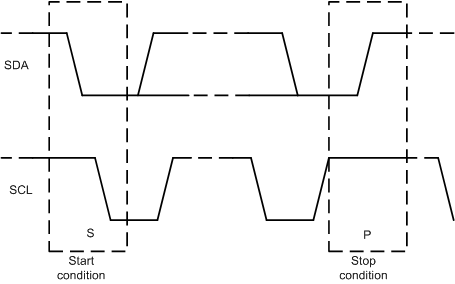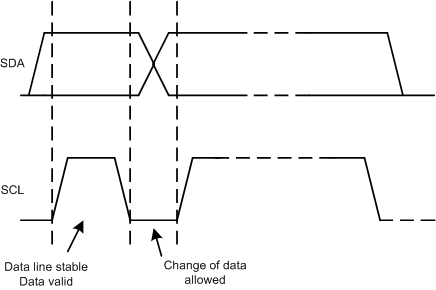ZHCSRN7A January 2023 – September 2023 DAC539G2-Q1
PRODUCTION DATA
- 1
- 1 特性
- 2 应用
- 3 说明
- 4 Revision History
- 5 Pin Configuration and Functions
-
6 Specifications
- 6.1 Absolute Maximum Ratings
- 6.2 ESD Ratings
- 6.3 Recommended Operating Conditions
- 6.4 Thermal Information
- 6.5 Electrical Characteristics: Voltage Output
- 6.6 Electrical Characteristics: Comparator Mode
- 6.7 Electrical Characteristics: General
- 6.8 Timing Requirements: I2C Standard Mode
- 6.9 Timing Requirements: I2C Fast Mode
- 6.10 Timing Requirements: I2C Fast Mode Plus
- 6.11 Timing Requirements: SPI Write Operation
- 6.12 Timing Requirements: SPI Read and Daisy Chain Operation (FSDO = 0)
- 6.13 Timing Requirements: SPI Read and Daisy Chain Operation (FSDO = 1)
- 6.14 Timing Requirements: GPIO
- 6.15 时序图
- 6.16 典型特性:电压输出
- 6.17 Typical Characteristics: Comparator
- 6.18 典型特性:通用
-
7 Detailed Description
- 7.1 Overview
- 7.2 Functional Block Diagram
- 7.3 Feature Description
- 7.4 Device Functional Modes
- 7.5 Programming
- 7.6
Register Maps
- 7.6.1 NOP Register (address = 00h) [reset = 0000h]
- 7.6.2 DAC-X-VOUT-CMP-CONFIG Register (address = 15h, 03h) [reset = 0400h]
- 7.6.3 COMMON-CONFIG Register (address = 1Fh) [reset = 03F9h]
- 7.6.4 COMMON-TRIGGER Register (address = 20h) [reset = 0000h]
- 7.6.5 FUNCTION-TRIGGER Register (address = 21h) [reset = 0001h]
- 7.6.6 GENERAL-STATUS Register (address = 22h) [reset = 2068h]
- 7.6.7 DEVICE-MODE-CONFIG Register (address = 25h) [reset = 8040h]
- 7.6.8 INTERFACE-CONFIG Register (address = 26h) [reset = 0000h]
- 7.6.9 STATE-MACHINE-CONFIG Register (address = 27h) [reset = 0003h]
- 7.6.10 SRAM-CONFIG Register (address = 2Bh) [reset = 0000h]
- 7.6.11 SRAM-DATA Register (address = 2Ch) [reset = 0000h]
- 7.6.12 FUNCTION-CONFIG Register (SRAM address = 20h) [reset = 007Ah]
- 7.6.13 FUNCTION-MAX Register (SRAM address = 21h) [reset = B900h]
- 7.6.14 FUNCTION-MIN Register (SRAM address = 22h) [reset = 1900h]
- 7.6.15 GPI-DEBOUNCE Register (SRAM address = 23h) [reset = 0138h]
- 7.6.16 VOUT-DATA-X Register (SRAM address = 24h to 2Bh) [reset = see #GUID-D64978E3-E8F0-4408-A2C1-8C72D24777EC/X6961 ]
- 7.6.17 PWM-FREQUENCY-ERROR Register (SRAM address = 9Eh) [reset = device-specific]
- 8 Application and Implementation
- 9 Device and Documentation Support
- 10Mechanical, Packaging, and Orderable Information
7.5.2.1 F/S Mode Protocol
The following steps explain a complete transaction in F/S mode.
- The controller initiates data transfer by generating a start condition. Figure 7-12 shows that the start condition is when a high-to-low transition occurs on the SDA line while SCL is high. All I2C-compatible devices recognize a start condition.
- The controller then generates the SCL pulses, and transmits the 7-bit address and the read/write direction bit (R/W) on the SDA line. During all transmissions, the controller makes sure that data are valid. Figure 7-13 shows that a valid data condition requires the SDA line to be stable during the entire high period of the clock pulse. All devices recognize the address sent by the controller and compare the address to the respective internal fixed address. Only the target device with a matching address generates an acknowledge by pulling the SDA line low during the entire high period of the 9th SCL cycle (see also Figure 7-11). When the controller detects this acknowledge, the communication link with a target has been established.
- The controller generates further SCL cycles to transmit (R/W bit 0) or receive (R/W bit 1) data to the target. In either case, the receiver must acknowledge the data sent by the transmitter. The acknowledge signal can be generated by the controller or by the target, depending on which is the receiver. The 9-bit valid data sequences consists of eight data bits and one acknowledge-bit, and can continue as long as necessary.
- Figure 7-12 shows that to signal the end of the data transfer, the controller generates a stop condition by pulling the SDA line from low-to-high while the SCL line is high. This action releases the bus and stops the communication link with the addressed target. All I2C-compatible devices recognize the stop condition. Upon receipt of a stop condition, the bus is released, and all target devices then wait for a start condition followed by a matching address.
 Figure 7-12 Start and Stop
Conditions
Figure 7-12 Start and Stop
Conditions Figure 7-13 Bit Transfer on the
I2C Bus
Figure 7-13 Bit Transfer on the
I2C Bus